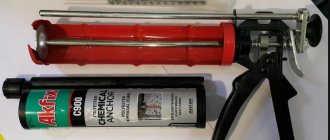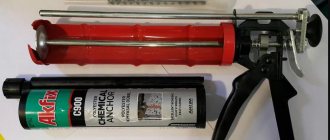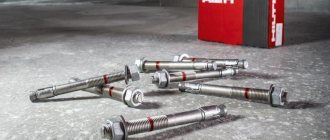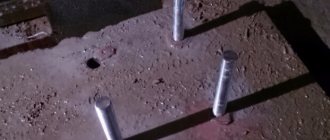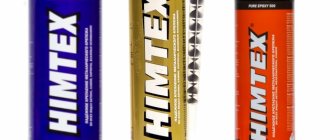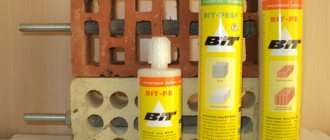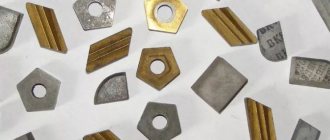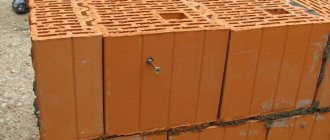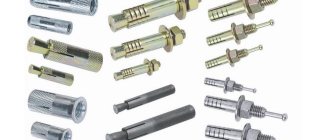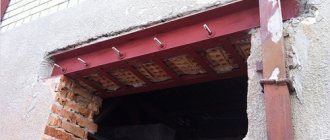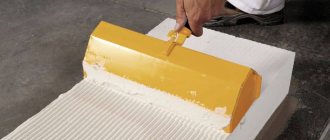Fastening products such as concrete anchors can ensure reliable fixation of various objects and structures on concrete surfaces. The problem of attaching various objects to concrete is quite relevant both in the field of capital construction and in the field of repairs carried out by the owners of real estate themselves.
Concrete anchors can provide reliable fastening of any structure
Such difficulties do not arise if the fastener needs to be fixed in a softer material - wood or plastic. If we are talking about concrete, a material characterized by high hardness and, accordingly, fragility, then it is necessary to use special fasteners, which, in particular, include anchor-type bolts.
What is an anchor: general concept
The word “anchor” means a fastener used for fixing various objects on structures made of solid solid materials - concrete, building bricks, natural stone, etc. To install such fasteners, you should prepare a hole with the appropriate dimensions in which the anchor-type bolt will be placed . The high holding capacity of a bolt placed in such a hole can be ensured by:
- friction forces (expansion-type anchor products);
- adhesive abilities of a special composition (chemical anchor elements);
- a special thrust element interacting with the inner walls of the hole.
Any anchor has a spacer part
The most popular anchor is a fastening element, which, due to its design features, is wedged inside the hole, thereby ensuring high reliability of the connection being created. The surface of such bolts, made of carbon steel, is coated with a zinc composition, which eliminates the risk of the occurrence and development of corrosion.
Wedge anchor B fvz
Wedge anchor B fvz
More details
Wedge anchor B fvz
WEDGE ANCHOR B FVZ Wedge anchor B FVZ is the optimal fastening element option for internal..
More details
The company's website presents all types of wedge anchors with their detailed descriptions. Ordering goods is very simple. All you need to do is fill out an application in your personal account or call the phone number listed on the website. Company managers will advise on all issues of interest.
Anchor bolt sizes for concrete
Typically, the main dimensions of the anchor bolt are indicated in the format, for example: M10 12x100. This designation is deciphered as follows: M10 is the diameter of the bolt thread, the number 12 indicates the installation diameter in millimeters (a hole of this diameter must be drilled in concrete before installation), the number 100 is the length of the anchor in millimeters.
The range of standard sizes of anchors used in everyday life, as a rule, is limited by these parameters: thread from M6 to M12 with a length from 55 to 160 mm. Of course, there are many other options, but they most likely fall into the category of professional or highly specialized fasteners.
Wedge anchor B
Wedge anchor B
More details
Wedge anchor B
Wedge anchor B Wedge anchor B from the German manufacturer MKT is made by cold forming..
More details
Features of installation of anchors for concrete
The reliability of fastening obtained using an anchor bolt is influenced by a number of factors:
- the quality of the material in which the anchor is installed;
- the type and dimensions of the fastening element, which must be selected in accordance with the loads perceived by such a product;
- correct preparation of the site for placing fasteners and compliance with the technology for its installation;
- strength characteristics of the anchor itself.
Sequence of installation operations (click to enlarge)
Installation of anchor-type bolts can be carried out in various structures, the material of which must be of sufficiently high strength. These include, in particular:
- concrete foundations;
- walls and partitions made of concrete and brick;
- floor slabs, which are usually made of concrete.
Mechanical anchor installation diagrams
Objects and structural elements that are fastened with such bolts are usually:
- beams made of rolled metal of various types;
- elements of suspended ceiling structures;
- lamps and chandeliers;
- wooden beams used for installation of floor and ceiling coverings;
- elements of staircase structures;
- load-bearing structures with large weight and dimensions.
Load calculation depending on anchor parameters
As mentioned above, fixing an anchor-type bolt inside a pre-prepared hole can be achieved in two main ways:
- by wedging the spacer sleeve inside the hole;
- due to a special adhesive composition that binds the bolt and the inner walls of the hole (chemical anchor).
There are requirements for holes in the fastened part, which should not exceed the values specified in the table. Large gaps can be filled with mortar
Specifications
The calculation is made in accordance with the installation regulations, filling the hole 2/3. The installation is considered correct if excess chemical composition comes out of the hole. In the case of using a mesh sleeve (hollow bases), it is necessary to add 30%, since in this case the sleeve is filled completely!
| anchor diameter (mm) | hole diameter (mm) | standard hole depth (mm) | filling volume per hole (ml) | number of holes from cartridge 300 (ml) | number of holes from cartridge 400 (ml) |
| M8 | 10 | 80 | 4.14 | 72.4 | 96.5 |
| M10 | 12 | 90 | 6.71 | 44.7 | 59.6 |
| M12 | 14 | 110 | 11.17 | 26.9 | 35.8 |
| M16 | 18 | 125 | 20.98 | 14.3 | 19.1 |
| M20 | 24 | 170 | 50.73 | 5.9 | 7.9 |
| M24 | 28 | 210 | 85.30 | 3.5 | 4.7 |
| M30 | 35 | 280 | 177.71 | 1.7 | 2.3 |
Mechanical Anchor Bolts for Concrete
The most common types of anchor bolts include fasteners that operate on a mechanical principle.
Drivers
One such product is a drive-in anchor, which has a thread inside the spacer sleeve. This anchor, designed for concrete and other dense and hard materials, is expanded in the hole using a special device, after which the fastener itself is screwed into it.
Types and installation procedure of a drive-in anchor
Spacers
Expansion anchors for concrete and other building materials are also widespread on the modern market. In the design of such anchor fasteners, which can withstand very significant loads, there is a special wedge, which is responsible for expanding the spacer sleeve. Using such anchors, it is possible to ensure reliable fixation of even heavy objects on a concrete surface - metal gates, large equipment, etc. Meanwhile, it should be borne in mind that the reliability of fastening that such an anchor provides for concrete work largely depends on the strength characteristics structure in which it is installed.
Expansion anchor HILTI HSL-3
One of the representatives of this family of fasteners is the frame anchor. Bolts of this type are used for installing windows and doors. The spacer sleeve of frame anchors has two wedging zones: at the bolt head and in the body of the load-bearing base.
Double spacer anchors for concrete, as their name suggests, have two spacer sleeves at the same time. Due to this, anchors of this type provide a more reliable grip, which allows them to be used for mounting objects of significant mass.
Metal frame anchors are designed for through-hole installation in brick, stone and concrete
Wedge
The wedge-type anchor for concrete, mentioned above, can have two design options. In the first case, a hammer and a special punch bit are used to wedge the inner sleeve of such an anchor. After wedging the sleeve, such an additional device is removed from the inside of the anchor and a fastening bolt or pin is screwed into it.
When twisting the wedge anchor, the pin is pulled out and wedges the spacer skirt with its cone-shaped shank
Installing other types of wedge anchors in concrete is somewhat simpler. Their main element is a threaded rod, one end of which is cone-shaped. When tightening the nut, which rests on the surface of the structure in which such a fastener is installed, its conical part expands the spacer sleeve, ensuring its reliable fixation in a pre-prepared hole. In some models of anchor fasteners of this type, there are teeth on the outer surface of the spacer sleeve, which provide better adhesion of this element to the inner walls of the hole.
Rod anchor for adjustable floor
The rod anchor, which is also a wedge type, differs from the usual one in its increased dimensions (bolt length). Using this anchor, multilayer systems with significant thickness are installed.
The choice of the type of anchor is made based not only on its dimensions, which are specified by GOST, but also on the type of fastening that must be performed with its help. It is also important to calculate the load that will fall on the concrete anchor. When performing this calculation, it should be borne in mind that the load on the fastening element should not exceed 25% of that indicated by GOST.
Can wedge anchors be used in foundations other than concrete?
Wedge anchors are designed for installation in solid concrete foundations only. They cannot be used in brick, block or mortar joints. Although natural materials such as stone and granite can also be quite hard, their uniformity and holding power have not been tested.
Concrete, unlike brick, stone, blocks and other materials, has a certain measurable strength, which is taken into account when designing anchors. The higher its strength, the higher the load-bearing capacity of the fastening. If the strength of concrete is not known, then the lowest strength class is taken into account.
The design of the wedge anchor is such that the bursting force is created not along its entire length, but in a certain zone. Its spacer part should rest against solid material. Brick, for example, is a fairly brittle material and may have hollow areas. If there is a high concentration of stress in one place, it can crumble. If the expansion zone of the wedge anchor falls into the void, then fixation will not occur at all.
Blocks made of foam concrete and aerated concrete are an even weaker base for installing such anchors. Hole walls in blocks are not strong enough to withstand local expansion forces, and large cavities in hollow blocks create unsafe anchoring areas.
Type and magnitude of load
The wedge type anchor should only be used under static loading conditions, that is, the attached load should not vibrate or be subjected to shock loads, as this can weaken the connection and even pull out the fastener. An example of such a use would be securing a flagpole or vibrating equipment. For such applications, chemical fasteners are the best solution.
Calculated pullout and shear forces
for anchor studs of different diameters are given in the table:
| Diameter, mm | M6 | M8 | M10 | M12 | M16 | M20 | |
| Concrete B20 (compressed) | Design pullout force, kN | 4.2 | 6.0 | 10.7 | 13.3 | 23.3 | 33.3 |
| Design shear force, kN | 4.0 | 7.3 | 11.6 | 16.8 | 31.4 | 49.0 | |
| Concrete B20 (stretched) | Design pullout force, kN | 2.2 | 3.3 | 6.0 | 8.0 | 16.7 | 20.0 |
| Design shear force, kN | 4.0 | 7.3 | 11.6 | 16.8 | 31.4 | 49.0 | |
The table shows that the same fastener in a compressed zone of concrete can withstand almost twice as much pullout force as in a tensile zone with cracks. To ensure the reliability of the anchor fastening, a safety factor of 4:1 is adopted, that is, the permissible load should be 25% of the calculated pull-out load.
terms of Use
This type of hardware is produced from galvanized and stainless steel with varying degrees of corrosion resistance:
- carbon galvanized steel
- for dry rooms; - hot-dip galvanized steel
– for wet rooms and outdoor installation; - stainless steel A2
(AISI 304) – for outdoor use and underwater installation; - Stainless steel A4
(AISI 316) – for use in caustic environments, immersion in sea and chlorinated water.
Minimum base thickness
The thickness of the base material is equally important, since thin-walled concrete structures cannot guarantee the stated holding strength. After installing the fastener, the distance from its end to the edge of the concrete slab should be at least 1.5 times the diameter. That is, if M12 fasteners are installed to a depth of 82 mm, then the minimum thickness of the building base for it is 100 mm.
Distance between fasteners
When installing structures, the question often arises: what is the minimum step to install the wedge anchor? If the attachment points are placed too close to each other, the stress zones of each of them are summed up, and a crack may appear in the concrete. In reference materials on the technology of installing anchor fastenings, it is recommended to adhere to the following rule: center distances - at least 10 anchor diameters, edge distances - at least 5.
| Diameter, mm | M6 | M8 | M10 | M12 | M16 | M20 |
| Standard center distance, mm | 120 | 141 | 180 | 210 | 246 | 303 |
| Minimum center distance, mm | 50 | 55 | 60 | 70 | 90 | 110 |
| Standard distance from edge, mm | 60 | 71 | 90 | 105 | 123 | 152 |
| Minimum distance from the edge, mm | 45 | 50 | 55 | 60 | 70 | 130 |
Anchor diameter and length
The main factors that determine the load-bearing capacity of a fastener are: the strength of concrete, the diameter of the fastener and the depth of its embedding in the base. The heavier the object being attached, the larger the diameter of the anchor. When calculating the length, it is necessary to sum up three parameters: the installation depth, the thickness of the attached element and the length of the protruding end of the stud onto which the fastening nut and washer will be screwed.
Hole diameter and depth
The diameter of the hole must be equal to the diameter of the wedge anchor. Hole depth and anchorage depth are two different parameters. Anchoring depth is the minimum depth of the stud below the concrete surface at which the minimum loads are achieved. Manufacturers usually indicate this value in the characteristics of fasteners. Deeper immersion is possible, but it will not significantly affect the permissible loads. The length of the hole should be at least 6-12 mm greater than the depth of the fastener. This additional space will collect any sludge generated during the installation process.
What is an anchor: general concept
The word “anchor” means a fastener used for fixing various objects on structures made of solid solid materials - concrete, building bricks, natural stone, etc. To install such fasteners, you should prepare a hole with the appropriate dimensions in which the anchor-type bolt will be placed . The high holding capacity of a bolt placed in such a hole can be ensured by:
- friction forces (expansion-type anchor products);
- adhesive abilities of a special composition (chemical anchor elements);
- a special thrust element interacting with the inner walls of the hole.
Any anchor has a spacer part
The most popular anchor is a fastening element, which, due to its design features, is wedged inside the hole, thereby ensuring high reliability of the connection being created. The surface of such bolts, made of carbon steel, is coated with a zinc composition, which eliminates the risk of the occurrence and development of corrosion.
Anchor bolt sizes for concrete
Typically, the main dimensions of the anchor bolt are indicated in the format, for example: M10 12x100. This designation is deciphered as follows: M10 is the diameter of the bolt thread, the number 12 indicates the installation diameter in millimeters (a hole of this diameter must be drilled in concrete before installation), the number 100 is the length of the anchor in millimeters.
The range of standard sizes of anchors used in everyday life, as a rule, is limited by these parameters: thread from M6 to M12 with a length from 55 to 160 mm. Of course, there are many other options, but they most likely fall into the category of professional or highly specialized fasteners.
Wedge anchor B A4 (Stainless steel version)
Wedge anchor B A4 (Stainless steel version)
More details
Wedge anchor B A4 (Stainless steel version)
WEDGE Anchor B A4 (STAINLESS VERSION) Wedge anchor B A4 is made of austenitic stainless steel..
More details
Features of installation of anchors for concrete
The reliability of fastening obtained using an anchor bolt is influenced by a number of factors:
- the quality of the material in which the anchor is installed;
- the type and dimensions of the fastening element, which must be selected in accordance with the loads perceived by such a product;
- correct preparation of the site for placing fasteners and compliance with the technology for its installation;
- strength characteristics of the anchor itself.
Sequence of installation operations (click to enlarge)
Installation of anchor-type bolts can be carried out in various structures, the material of which must be of sufficiently high strength. These include, in particular:
- concrete foundations;
- walls and partitions made of concrete and brick;
- floor slabs, which are usually made of concrete.
Mechanical anchor installation diagrams
Objects and structural elements that are fastened with such bolts are usually:
- beams made of rolled metal of various types;
- elements of suspended ceiling structures;
- lamps and chandeliers;
- wooden beams used for installation of floor and ceiling coverings;
- elements of staircase structures;
- load-bearing structures with large weight and dimensions.
Load calculation depending on anchor parameters
As mentioned above, fixing an anchor-type bolt inside a pre-prepared hole can be achieved in two main ways:
- by wedging the spacer sleeve inside the hole;
- due to a special adhesive composition that binds the bolt and the inner walls of the hole (chemical anchor).
There are requirements for holes in the fastened part, which should not exceed the values specified in the table. Large gaps can be filled with mortar
Installation of M12 anchor bolt
Installing an M12 anchor bolt is not difficult. Below is the sequence of steps.
First, a hole with a diameter of 12 mm is drilled in the base.
Next, using a syringe, particles of the base material and dust are removed from the drilled hole.
At the third stage, the anchor bolt is threaded into the mounting hole of the object to be suspended and inserted into the hole drilled at stage No. 1. After this, the anchor must be driven in all the way with a mallet or hammer.
Finally, in the fourth stage, the bolt head is tightened about 4-5 turns. But it is better to do this with a torque wrench. Tightening torque – 30 Nm.
Mechanical Anchor Bolts for Concrete
The most common types of anchor bolts include fasteners that operate on a mechanical principle.
Drivers
One such product is a drive-in anchor, which has a thread inside the spacer sleeve. This anchor, designed for concrete and other dense and hard materials, is expanded in the hole using a special device, after which the fastener itself is screwed into it.
Types and installation procedure of a drive-in anchor
Spacers
Expansion anchors for concrete and other building materials are also widespread on the modern market. In the design of such anchor fasteners, which can withstand very significant loads, there is a special wedge, which is responsible for expanding the spacer sleeve. Using such anchors, it is possible to ensure reliable fixation of even heavy objects on a concrete surface - metal gates, large equipment, etc. Meanwhile, it should be borne in mind that the reliability of fastening that such an anchor provides for concrete work largely depends on the strength characteristics structure in which it is installed.
Expansion anchor HILTI HSL-3
One of the representatives of this family of fasteners is the frame anchor. Bolts of this type are used for installing windows and doors. The spacer sleeve of frame anchors has two wedging zones: at the bolt head and in the body of the load-bearing base.
Double spacer anchors for concrete, as their name suggests, have two spacer sleeves at the same time. Due to this, anchors of this type provide a more reliable grip, which allows them to be used for mounting objects of significant mass.
Metal frame anchors are designed for through-hole installation in brick, stone and concrete
Wedge
The wedge-type anchor for concrete, mentioned above, can have two design options. In the first case, a hammer and a special punch bit are used to wedge the inner sleeve of such an anchor. After wedging the sleeve, such an additional device is removed from the inside of the anchor and a fastening bolt or pin is screwed into it.
When twisting the wedge anchor, the pin is pulled out and wedges the spacer skirt with its cone-shaped shank
Installing other types of wedge anchors in concrete is somewhat simpler. Their main element is a threaded rod, one end of which is cone-shaped. When tightening the nut, which rests on the surface of the structure in which such a fastener is installed, its conical part expands the spacer sleeve, ensuring its reliable fixation in a pre-prepared hole. In some models of anchor fasteners of this type, there are teeth on the outer surface of the spacer sleeve, which provide better adhesion of this element to the inner walls of the hole.
Rod anchor for adjustable floor
The rod anchor, which is also a wedge type, differs from the usual one in its increased dimensions (bolt length). Using this anchor, multilayer systems with significant thickness are installed.
The choice of the type of anchor is made based not only on its dimensions, which are specified by GOST, but also on the type of fastening that must be performed with its help. It is also important to calculate the load that will fall on the concrete anchor. When performing this calculation, it should be borne in mind that the load on the fastening element should not exceed 25% of that indicated by GOST.
Chemical Anchor Bolts for Concrete
A fastener of this type is a concrete anchor screw, the fixation of which in the hole is ensured by a special adhesive composition. The adhesive composition with which chemical anchors are fixed is poured into a pre-made and thoroughly cleaned hole to two-thirds of its length. An anchor bolt of the appropriate size is installed in the hole with glue. After the adhesive composition has completely hardened, the required item is attached.
The battery-powered dispenser allows you to introduce the adhesive composition quickly and accurately
Design features and scope
The anchor bolt with fixing nut consists of the following parts:
- a metal rod with a threaded part on one side and a conical part on the other;
- a spacer sleeve, through which objects are fixed to any surface or relative to each other;
- nuts, with the help of which the fixation (fastening) is carried out. The anchor bolt nut is made of high-strength materials with an additional protective coating and can be of various shapes, for example, hexagonal.
The main components of the design of an anchor with a nut
Using this type of fastener you can:
- assemble structures consisting of several elements, for example, towers for power lines, lighting poles, fences, and so on;
- to carry out fastening of certain types of structures to the floor, ceiling, wall, asphalt and so on, both at the industrial and domestic levels.
How does an anchor fastener with a nut work?
Taking into account the fact that this fastening mechanism must hold quite heavy elements, it was carefully thought out and redesigned. The main structural element in it is a spacer pin, which has a cone shape at one end, and a metric thread is cut at the other end, onto which a nut is screwed. The entire length of the stud, except for the threaded part, is fitted with a special metal sleeve with slots.
This device works on the principle of “expansion”, that is, when we start to tighten the nut, the cone-shaped end enters the sleeve and expands it in the hole. A distinctive feature is that such an anchor has a cast pin, which is much stronger than other anchor structures. Well, and, of course, we forgot to mention the nut and, without fail, the lock washer, which are screwed on from the thread side. The washer does not allow the nut to go deeper into the hole when tightening.
In some cases, during fastening, installers use a second washer as an additional lock, which closes the hole at the installation site, but this approach depends on the specific installation conditions.
The scope of application of such fasteners can be quite different: from the installation of stair railings to heavy metal structures. The most popular application today is the installation of brackets for air conditioning. The device itself has quite a decent weight, so the use of such a mount is completely justified.
Anchor bolt with nut - weight, dimensions: what does GOST tell us?
Since all fasteners are complex installation products, they all have appropriate technical documentation. It is from such documents that we can find out technical parameters if necessary. For example, when choosing this or that fastener, we want to know whether the anchor fastening will withstand a weight of 100 kilograms or not. Thanks to the fact that there is documentation, we will receive an answer to our question.
The smallest anchor, whose dimensions are 5x6.5x18 mm, according to the manufacturer's stated characteristics, is capable of withstanding a pullout load of up to 800 kgf.
To make it clearer, kgf is the designation of kilogram/force, where the calculation takes into account the mass of one kilogram and the force with which this kilogram exerts pressure on the scale. Further calculations are quite simple, 1 kgf is equal to approximately one kilogram of any object, based on this, such an anchor will support a product weighing 800 kilograms.
Also, absolutely any bolt has a corresponding GOST, which divides all fastening structures into varieties according to their ability to withstand a certain load, the size and diameter of the fastening element. On large construction sites, such documentation helps in the selection of fastening elements and the purchase of appropriate materials.
Technical characteristics of anchor bolts
Technical documentation recommends installing such fastenings in solid solid materials, such as concrete, solid brick, natural stone. In each individual case, we must choose a bolt and nut whose dimensions will provide us with high-quality fastening. But it is worth remembering that during installation, when tightening the nut, the stud moves forward a certain distance; as a result, sometimes this length creates an obstacle when installing the products that we are fastening.
Today in stores you can find fasteners of almost any length, for various types of tasks. As a rule, the line of anchor fastenings begins with a stud size of 18 millimeters.
The longest fastener reaches 400 millimeters in net size of the fastening pin. Accordingly, depending on the length, we also have different diameters; this value is calculated by the diameter of the sleeve for which the hole is drilled.
The diameter of the bushing usually starts from 6.5 millimeters, this is, as a rule, the smallest anchor; gradually, as the length increases, the diametrical value also increases; on the longest fastening, the bushing can be 20 millimeters in circumference, and such fasteners can withstand quite significant loads. If you are interested in the holding force of such fasteners, you can find it out from the technical documentation, we talked about it earlier.
When choosing an anchor, always consider the thickness of the surface on which the installation will be made. Long does not mean durable, and besides, you risk getting a through hole, which is undesirable when installing the fastener.
Reinforced version - double-spacer fastener
Due to the fact that consumer requirements are constantly growing, and there is a need for the installation of fairly heavy structures, it was decided to slightly modify the fasteners. This is how a modified product appeared on the building materials market - an anchor bolt with a double-spacer nut. This technology has made it possible to sufficiently increase the holding force of such fastenings.
The design itself is the same pin, but in this case two bushings are used as a holding mechanism, one of which is wedge-shaped and fits into the second bushing. Thus, by tightening the nut, we increase the holding properties, evenly distributing the force along the entire length of the fastener. The double-spacer anchor with a ring uses the same technology in its design, and, as practice shows, quite successfully.
This modified fastening is used mainly in production, but not only in the construction environment. For example, very often this mounting element is used to fasten machine tools in workshops.
Usually, during operation, the machine creates a certain vibration, which, as a rule, is not needed, and if previously the machine was simply attached to the floor using concrete, today the easiest way is to use a universal mount and get rid of unwanted vibration during operation.
What types of anchors?
Types of anchors: correct fastening
- Anchor bolt with nut
- Wedge anchor
- Ceiling anchor
with ring (eye) - anchor bolt
- Double spacer anchor
- Expandable anchor
- Frame anchor
- Nail anchors
Interesting materials:
What is a voltage indicator for? Why do plants need calcium? Why do you need a roof drip line? What is holofiber needed for? What is cosmofen glue used for? What is a clamper for? Why do you need a ridge on the roof? Why do you need a Megaohmmeter? What is Vernier used for? Why do you need an air purifier at home?
How to properly install an anchor bolt with a nut - step-by-step diagram
Step 1: Anchor Hole Diameter
Before drilling a hole for the fastening, you need to select a concrete drill for a hammer drill of the required diameter. In this case, first of all, be guided by the dimensions of your mount. It is under no circumstances recommended to drill a hole if the bushing does not fit into it. It is better to go through the same diameter drill again, and the hole will become a little larger. If you drill out the fastening point with a drill of a larger diameter, the bushing can freely “walk” in it, while the spacer mechanism simply cannot perform its holding functions.
Step 2: Clear the mounting area of debris
It is no secret that after drilling, debris remains in the finished hole after using a hammer drill. It is these crumbs and dust that interfere with the installation of the bolt at the installation site. It is especially difficult to install a double-spacer mechanism into an uncleaned hole; such fasteners have a sleeve that is slightly wider than usual. Therefore, before installation, thoroughly clean the hole; if necessary, use a construction or household vacuum cleaner.
Step 3: Correct installation of heavy elements
After you have inserted the bolt into the hole, do not rush to mount your device while tightening the nuts; there is a more practical solution. After installing the anchor, without hanging the product, tighten the bolt with a wrench until it stops. Tightening must be carried out until the pin opens the bushing, and the fastening, so to speak, assumes operating mode. After this, you can place the nut on the studs, which are already firmly held in the mounting hole, install the device, and calmly tighten it with the nuts.
Wedge anchor installation technique
- Holes are made in the fastening material and the part to be attached. The size of the holes must match the size of the anchor.
- Clean the finished holes from small stones and dust. Thorough cleaning of the surface is not necessary.
- Place the parts to be fastened so that the holes match.
- Place the wedge anchor into the finished hole and hammer it in so that the plane of the wedge fits completely. Its plane should coincide with the locking cap.
For a reliable fastening that will last a long time, it is necessary to install the fasteners correctly.
Bolt Load Calculation
The bolt head markings usually contain the following information:
- manufacturer's mark (JX, THE, L, WT, etc.);
- strength class;
- arrow “counterclockwise” (if left-hand thread).
The first digit indicates the nominal tensile strength (tensile strength): 1/100 MPa (1/100 N/mm²;
1/10 kg/mm²). Example: (strength class 9.8) 9*10=900 MPa (900 N/mm²; 91.71 kg/mm²).
The second number indicates the percentage of yield strength to tensile strength (tensile strength): 1/10%. Example: (strength class 9.8) 9*8=720 MPa (720 N/mm²; 73.37 kg/mm²).
The yield strength value is the maximum permissible working load of the bolt, above which irreversible deformation occurs. When calculating the load, 1/2 or 1/3 of the yield strength is used, with a double or triple safety margin, respectively.
According to the current international classification, high-strength bolts include products whose tensile strength is greater than or equal to 800 MPa (800 N/mm²; 81.52 kg/mm²). Accordingly, starting from 8.8 for bolts and 8 for nuts.
Examples of material flow
An example would be a common kitchen fork. By bending it in one direction, you can get a completely different object, which means its fluidity is disrupted, which leads to deformation. In this case, the material only deformed, but did not break, which indicates a high degree of elasticity of the steel. Conclusion: maximum strength is much higher than yield.
Other kitchen equipment, such as a knife, will break if you try to change its shape. Conclusion: the knife has the same fluidity and strength; such a product can be called fragile, despite the fact that it is made of steel.
A similar practical example would be screwing in a nut: the bolt itself increases in length only after a certain amount of action is applied to it. If the outcome of the experiment is unfavorable, the thread on the fastener may break.
The percentage of elongation is an average indicator that demonstrates the length of the deformed part before the onset of failure. Figuratively, we can call this kind of bolts flexible, meaning precisely the ability to elongate.
The technical terminology for this is quite simple: elongation is nothing more than the percentage of increase in a sample compared to its original size.
Material hardness
Brinell hardness is a characteristic that allows you to determine the hardness of a material.
Stainless steel fasteners are also equipped with special markings on the top of the fastener.
Type of steel A2 or A4 and tensile strength - 50, 70, 80, examples: A2-70, A4-80. Fasteners that have a clearly defined thread are color-coded for A2 in green and for A4 in red. The value for the yield strength is not specified.
For example, a value of 70 is the most standard and demonstrates the maximum strength of stainless steel fasteners.
Maximum fluidity for stainless steel hardware, often only a reference value.
The fluidity in this case will be 250 N/mm2 for A2-70 and about 300 N/mm2 for A4-80.
The approximate increase will be no more than 40%. In other words, this type of steel perfectly changes shape before irreparable deformation occurs.
Old domestic measurement methods according to GOST did not allow paying due attention to the maximum permissible loads on bolts, so the produced hardware was significantly lower in quality compared to modern ones.
An example to calculate the load on a material as accurately as possible using strength classification:
M12 fastening with strength 8.8, size d2 = 10.7 mm and maximum section length 89.87 mm2. In this case, the maximum permissible degree of load will be: (8*8*10)*89.87;0) = 57520 Newton.
Load chart for carbon steel and stainless steel bolts.
| ST-4.6 | ST-8.8 | A2-70 | A4-80 | |||||||
| THREAD | d2, mm | Area 62, tt2 | Max. load, Newton | Working load, kg | Max. load, Newton | Working load, kg | Max. load, Newton | Working load, kg | Max. load, Newton | Working load, kg |
| M1 | 0,8 | 0,5 | 121 | 322 | 10 | 126 | 151 | |||
| M2 | 1,7 | 2,27 | 544 | 20 | 1 452 | 70 | 567 | 20 | 681 | 30 |
| M3 | 2,6 | 5,31 | 1 274 | 60 | 3 396 | 160 | 1 327 | 60 | 1 592 | 70 |
| M4 | 3,5 | 9,62 | 2 308 | 110 | 6 154 | 300 | 2 404 | 120 | 2 885 | 140 |
| M5 | 4,4 | 15,2 | 3 647 | 180 | 9 726 | 480 | 3 799 | 180 | 4 559 | 220 |
| M6 | 5,3 | 22,05 | 5 292 | 260 | 14 112 | 700 | 5 513 | 270 | 6 615 | 330 |
| M8 | 7,1 | 39,57 | 9 497 | 470 | 25 326 | 1 260 | 9 893 | 490 | 11 872 | 590 |
| M10 | 8,9 | 62,18 | 14 923 | 740 | 39 795 | 1 980 | 15 545 | 770 | 18 654 | 930 |
| M12 | 10,7 | 89,87 | 21 570 | 1 070 | 57 520 | 2 870 | 22 469 | 1 120 | 26 962 | 1 340 |
| M14 | 12,6 | 124,63 | 29 910 | 1 490 | 79 761 | 3 980 | 31 157 | 1 550 | 37 388 | 1 860 |
| M16 | 14,6 | 167,33 | 40159 | 2 000 | 107 092 | 5 350 | 41 833 | 2 090 | 50199 | 2 500 |
| M20 | 18,3 | 262,89 | 63 093 | 3 150 | 168 249 | 8 410 | 65 722 | 3 280 | 78 867 | 3 940 |
| M24 | 21,9 | 376,49 | 90 359 | 4 510 | 240 956 | 12 040 | 94 123 | 4 700 | 112 948 | 5 640 |
| M27 | 24,9 | 486,71 | 116 810 | 5 840 | 311 493 | 15 570 | 121 677 | 6 080 | 146 012 | 7 300 |
| M30 | 27,6 | 597,98 | 143 516 | 7170 | 382 708 | 19130 | 149 495 | 7 470 | 179 394 | 8 960 |
We present to your attention an updated table of maximum loads on stainless materials and high-strength connections.
To be additionally confident in the safety of the load, you can, without a twinge of conscience, divide the load in Newtons by thirty.
| Stainless steel A2-50 | |||||||
| THREAD | d2, mm | Area d2, mm2 | Yield strength, MPa | Max. load, Newton | Working load, kg | ||
| M1 | 0,8 | 0,50 | 200 | 100 | |||
| M2 | 1.7 | 2,27 | 200 | 454 | 20 | ||
| M3 | 2,6 | 5,31 | 200 | 1 061 | 50 | ||
| M4 | 3,5 | 9,62 | 200 | 1 923 | 90 | ||
| M5 | 4,4 | 15,20 | 200 | 3 040 | 150 | ||
| MB | 5,3 | 22,05 | 200 | 4 410 | 220 | ||
| M8 | 7,1 | 39,57 | 200 | 7 914 | 390 | ||
| M10 | 8,9 | 62,18 | 200 | 12 436 | 620 | ||
| M12 | 10,7 | 89,87 | 200 | 17 975 | 890 | ||
| M14 | 12,6 | 124,63 | 200 | 24 925 | 1 240 | ||
| M16 | 14,6 | 167,33 | 200 | 33 466 | 1 670 | ||
| M20 | 18,3 | 262,89 | 200 | 52 578 | 2 620 | ||
| M24 | 21,9 | 376,49 | 200 | 75 299 | 3 760 | ||
| M27 | 24,9 | 486,71 | 200 | 97 342 | 4 860 | ||
| MLO | 27,6 | 597,98 | 200 | 119 596 | 5 970 | ||
| Stainless steel A2-70 | |||||||
| THREAD | 62.mm | Area d2, mm2 | Yield strength, MPa | Max. load, Newton | Working load, kg | ||
| M1 | 0,8 | 0,50 | 250 | 126 | |||
| M2 | 1,7 | 2,27 | 250 | 567 | 20 | ||
| M3 | 2,6 | 5,31 | 250 | 1 327 | 60 | ||
| M4 | 3,5 | 9,62 | 250 | 2 404 | 120 | ||
| M5 | 4,4 | 15,20 | 250 | 3 799 | 180 | ||
| MB | 5,3 | 22,05 | 250 | 5 513 | 270 | ||
| M8 | 7,1 | 39,57 | 250 | 9 893 | 490 | ||
| M10 | 8,9 | 62,18 | 250 | 15 545 | 770 | ||
| M12 | 10,7 | 89,87 | 250 | 22 469 | 1 120 | ||
| M14 | 12,6 | 124,63 | 250 | 31 157 | 1 550 | ||
| M16 | 14,6 | 167,33 | 250 | 41 833 | 2 090 | ||
| M20 | 18,3 | 262,89 | 250 | 65 722 | 3 280 | ||
| M24 | 21,9 | 376,49 | 250 | 94 123 | 4 700 | ||
| M27 | 24,9 | 486,71 | 250 | 121 677 | 6 080 | ||
| MLO | 27,6 | 597,98 | 250 | 149 495 | 7 470 | ||
| Stainless steel A4-80 | |||||||
| THREAD | 12, mm | Area d2, mm2 | Yield strength, MPa | Max. load, Newton | Working load, kg | ||
| M 1 | 0,8 | 0,50 | 300 | 151 | |||
| M2 | 1,7 | 2,27 | 300 | 681 | 30 | ||
| M3 | 2,6 | 5,31 | 300 | 1 592 | 70 | ||
| M 4 | 3,5 | 9,62 | 300 | 2 885 | 140 | ||
| M 5 | 4,4 | 15,20 | 300 | 4 559 | 220 | ||
| MB | 5,3 | 22,05 | 300 | 6 615 | 330 | ||
| M 8 | 7,1 | 39,57 | 300 | 11 872 | 590 | ||
| M10 | 8,9 | 62,18 | 300 | 18 654 | 930 | ||
| M12 | 10,7 | 89,87 | 300 | 26 962 | 1 340 | ||
| M14 | 12,6 | 124,63 | 300 | 37 388 | 1 860 | ||
| M16 | 14,6 | 167,33 | 300 | 50199 | 2 500 | ||
| M20 | 18,3 | 262,89 | 300 | 78 867 | 3 940 | ||
| M24 | 21,9 | 376,49 | 300 | 112 948 | 5 640 | ||
| M27 | 24,9 | 486,71 | 300 | 146 012 | 7 300 | ||
| MLO | 27,6 | 597,98 | 300 | 179 394 | 8 960 | ||
Wedge anchors
This type is also called an anchor bolt or a stud anchor. It is most widespread due to its ease of installation and high load-bearing capacity. Installed in stretched and compressed areas of concrete, natural stone.
Withstands high loads subject to a number of conditions:
- sufficient tightening force of the nut to create frictional clamping of the sleeve with the walls of the hole;
- exact correspondence of the hole diameter to the anchor diameter;
- sufficient strength of concrete and absence of sinks;
- meeting the requirements for distances from the edge and between attachment points.
Wedge anchor elements
Company Sormat
(Finland) has developed highly effective wedge anchors for concrete with adjustable tightening torque for through installation of heavy and medium-heavy structures. They are made of high quality cold-formed steel. The consumer is offered a wide selection of sizes and levels of corrosion protection:
- S-KA – electrogalvanized;
- S-KAK – hot-dip galvanized;
- S-KAH – made of stainless acid-resistant steel A4;
- S-KAD – with “Delta” coating.
Table 1. Dimensions, installation parameters and loads of anchors S-KA and S-KAK
| Marking | Anchor and drill diameter, mm | Anchor length, mm | Thickness of the mounted part, mm | Hole depth, mm | Min. anchorage depth, mm | Tightening torque, Nm | Loads (compressed zone of concrete C20/25) | |
| Breakout, kN | Shear, kN | |||||||
| 6x40 | 6 | 40 | 2 | 35 | 25 | 4 | 1,0 | 2,0 |
| 6/15x65 | 6 | 65 | 15 | 45 | 35 | 7 | 1,7 | 2,5 |
| 6/50x100 | 6 | 100 | 50 | 45 | 35 | 7 | 1,7 | 2,5 |
| 8x50 | 8 | 52 | 2 | 45 | 30 | 15 | 3,3 | 3,4 |
| 8/10x72 | 8 | 72 | 10 | 60 | 45 | 15 | 3,6 | 5,7 |
| 8/30x92 | 8 | 92 | 30 | 60 | 45 | 15 | 3,6 | 5,7 |
| 8/50x112 | 8 | 112 | 50 | 60 | 45 | 15 | 3,6 | 5,7 |
| 8/85x147 | 8 | 147 | 85 | 60 | 45 | 15 | 3,6 | 5,7 |
| 10x60 | 10 | 62 | 3 | 50 | 30 | 30 | 3,5 | 3,8 |
| 10/10x92 | 10 | 92 | 10 | 75 | 60 | 35 | 6,3 | 10,3 |
| 10/20x102 | 10 | 102 | 20 | 75 | 60 | 35 | 6,3 | 10,3 |
| 10/30x112 | 10 | 112 | 30 | 75 | 60 | 35 | 6,3 | 10,3 |
| 10/50x132 | 10 | 132 | 50 | 75 | 60 | 35 | 6,3 | 10,3 |
| 10/80x162 | 10 | 162 | 80 | 75 | 60 | 35 | 6,3 | 10,3 |
| 12x85 | 12 | 85 | 3 | 75 | 55 | 50 | 6,5 | 9,6 |
| 12/5x103 | 12 | 103 | 5 | 90 | 70 | 50 | 7,9 | 13,1 |
| 12/20x118 | 12 | 118 | 20 | 90 | 70 | 50 | 7,9 | 13,1 |
| 12/30x128 | 12 | 128 | 30 | 90 | 70 | 50 | 7,9 | 13,1 |
| 12/50x148 | 12 | 148 | 50 | 90 | 70 | 50 | 7,9 | 13,1 |
| 12/65x163 | 12 | 163 | 65 | 90 | 70 | 50 | 7,9 | 13,1 |
| 12/80x178 | 12 | 178 | 80 | 90 | 70 | 50 | 7,9 | 13,1 |
| 12/155x253 | 12 | 253 | 155 | 90 | 70 | 50 | 6,4 | 6,4 |
| 16x90 | 16 | 90 | 3 | 80 | 60 | 100 | 9,9 | 21,8 |
| 16/5x123 | 16 | 123 | 5 | 110 | 85 | 120 | 16,7 | 25,1 |
| 16/20x138 | 16 | 138 | 20 | 110 | 85 | 120 | 16,7 | 25,1 |
| 16/50/168 | 16 | 168 | 50 | 110 | 85 | 120 | 16,7 | 25,1 |
| 16/60x178 | 16 | 178 | 60 | 110 | 85 | 120 | 16,7 | 25,1 |
| 16/95x213 | 16 | 213 | 95 | 110 | 85 | 120 | 10,0 | 10,0 |
| 20/20x170 | 20 | 170 | 20 | 135 | 110 | 240 | 19,8 | 27,7 |
| 20/70x220 | 20 | 220 | 70 | 135 | 110 | 240 | 19,8 | 27,7 |
| 20/130x280 | 20 | 280 | 130 | 135 | 110 | 240 | 19,8 | 27,7 |
Mungo Company
(Switzerland) proposed its own version of wedge anchors, approved for use in crack-free concrete with a strength of at least 25 N/mm2 (C 20/25). The anchoring depth is marked on the stud for correct installation. The fastener is available in four versions:
Wedge anchor Mungo m2
- – with GreenTec coating and flat washer DIN 125A;
- m2f – hot-dip galvanized, coating thickness 40 microns;
- m2-C – with 5 micron zinc coating and wide washer DIN 9021;
- m2r – made of stainless steel A4 / 316.
| code | Thread | Loads in concrete C20/25 | Bending moment, Nm | Distance between fasteners, mm | Distance from edge, mm | Min. thickness of base material, mm | Tightening torque, Nm | |
| pullout, kN | shear, kN | |||||||
| m2, m2f | M6 | 3,6 | 2,1 | 5,8 | 120 | 60 | 100 | 5 |
| M8 | 5,7 | 3,9 | 14,3 | 150 | 75 | 100 | 15 | |
| M10 | 7,6 | 6,2 | 28,5 | 174 | 87 | 120 | 30 | |
| M12 | 8,3 | 8,4 | 46,8 | 204 | 102 | 140 | 50 | |
| M16 | 9,9 | 15,7 | 118,6 | 240 | 120 | 160 | 100 | |
| M20 | 16,5 | 24,5 | 231,5 | 300 | 150 | 200 | 200 | |
| m2-C | M8 | 5,7 | 3,9 | 14,3 | 150 | 75 | 100 | 15 |
| M10 | 7,6 | 6,2 | 28,5 | 174 | 87 | 120 | 30 | |
| M12 | 8,3 | 8,4 | 46,8 | 204 | 102 | 140 | 50 | |
| M16 | 9,9 | 15,7 | 118,6 | 240 | 120 | 160 | 100 | |
| m2r | M6 | 3,6 | 3,9 | 6,4 | 120 | 60 | 100 | 6,5 |
| M8 | 5,7 | 7,1 | 16,1 | 150 | 75 | 100 | 25 | |
| M10 | 7,6 | 11,2 | 32,2 | 174 | 87 | 120 | 35 | |
| M12 | 11,9 | 16,3 | 56,4 | 204 | 102 | 140 | 125 | |
| M16 | 14,3 | 30,3 | 142,8 | 240 | 120 | 160 | 140 | |
Table 2. Dimensions, installation parameters and loads of anchors m2, m2f, m2-C, m2r.
Note:
The table shows the recommended loads taking into account the safety factor of resistances, as well as the safety factor of the actual load yF = 1.4. Let us recall that 1 kN = 101.9 kg.
Technical data valid for single fastening installed in concrete C20/25
(minimum compressive strength 25 N/mm2), without taking into account the influence of edge (
C
) and interaxial (
S
) distances.
When reducing parameters S, C or the thickness of the concrete base, it is necessary to take into account reduction factors to clarify the pull-out and shear load.
